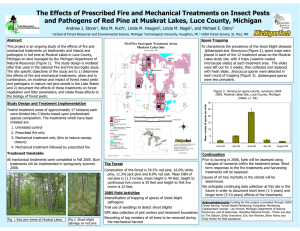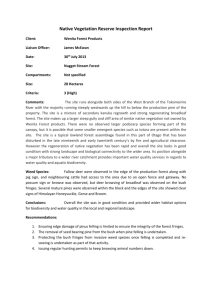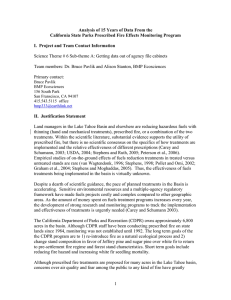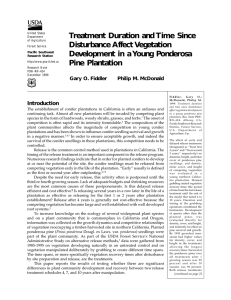, Linda M. Haugen , Linda M. Nagel Andrew J. Storer
advertisement
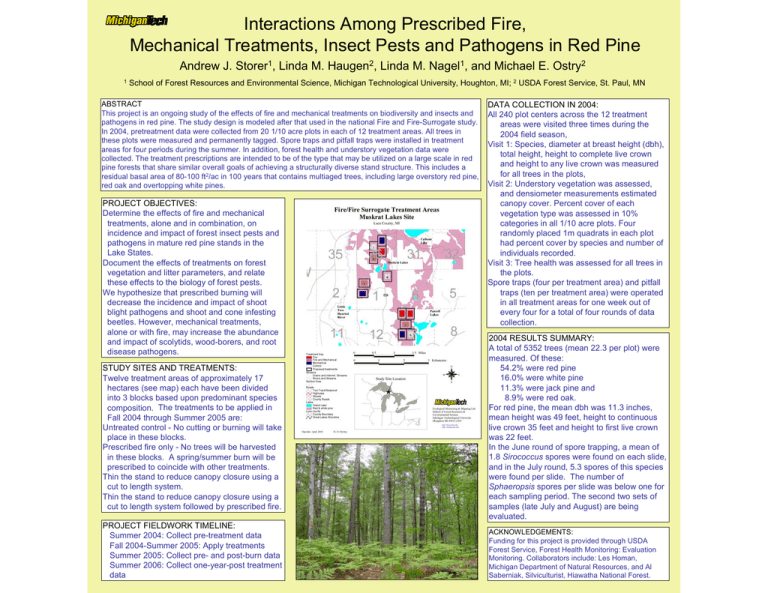
Interactions Among Prescribed Fire, Mechanical Treatments, Insect Pests and Pathogens in Red Pine Andrew J. Storer1, Linda M. Haugen2, Linda M. Nagel1, and Michael E. Ostry2 1 School of Forest Resources and Environmental Science, Michigan Technological University, Houghton, MI; 2 USDA Forest Service, St. Paul, MN ABSTRACT This project is an ongoing study of the effects of fire and mechanical treatments on biodiversity and insects and pathogens in red pine. The study design is modeled after that used in the national Fire and Fire-Surrogate study. In 2004, pretreatment data were collected from 20 1/10 acre plots in each of 12 treatment areas. All trees in these plots were measured and permanently tagged. Spore traps and pitfall traps were installed in treatment areas for four periods during the summer. In addition, forest health and understory vegetation data were collected. The treatment prescriptions are intended to be of the type that may be utilized on a large scale in red pine forests that share similar overall goals of achieving a structurally diverse stand structure. This includes a residual basal area of 80-100 ft2/ac in 100 years that contains multiaged trees, including large overstory red pine, red oak and overtopping white pines. PROJECT OBJECTIVES: Determine the effects of fire and mechanical treatments, alone and in combination, on incidence and impact of forest insect pests and pathogens in mature red pine stands in the Lake States. Document the effects of treatments on forest vegetation and litter parameters, and relate these effects to the biology of forest pests. We hypothesize that prescribed burning will decrease the incidence and impact of shoot blight pathogens and shoot and cone infesting beetles. However, mechanical treatments, alone or with fire, may increase the abundance and impact of scolytids, wood-borers, and root disease pathogens. STUDY SITES AND TREATMENTS: Twelve treatment areas of approximately 17 hectares (see map) each have been divided into 3 blocks based upon predominant species composition. The treatments to be applied in Fall 2004 through Summer 2005 are: Untreated control - No cutting or burning will take place in these blocks. Prescribed fire only - No trees will be harvested in these blocks. A spring/summer burn will be prescribed to coincide with other treatments. Thin the stand to reduce canopy closure using a cut to length system. Thin the stand to reduce canopy closure using a cut to length system followed by prescribed fire. PROJECT FIELDWORK TIMELINE: Summer 2004: Collect pre-treatment data Fall 2004-Summer 2005: Apply treatments Summer 2005: Collect pre- and post-burn data Summer 2006: Collect one-year-post treatment data DATA COLLECTION IN 2004: All 240 plot centers across the 12 treatment areas were visited three times during the 2004 field season, Visit 1: Species, diameter at breast height (dbh), total height, height to complete live crown and height to any live crown was measured for all trees in the plots, Visit 2: Understory vegetation was assessed, and densiometer measurements estimated canopy cover. Percent cover of each vegetation type was assessed in 10% categories in all 1/10 acre plots. Four randomly placed 1m quadrats in each plot had percent cover by species and number of individuals recorded. Visit 3: Tree health was assessed for all trees in the plots. Spore traps (four per treatment area) and pitfall traps (ten per treatment area) were operated in all treatment areas for one week out of every four for a total of four rounds of data collection. 2004 RESULTS SUMMARY: A total of 5352 trees (mean 22.3 per plot) were measured. Of these: 54.2% were red pine 16.0% were white pine 11.3% were jack pine and 8.9% were red oak. For red pine, the mean dbh was 11.3 inches, mean height was 49 feet, height to continuous live crown 35 feet and height to first live crown was 22 feet. In the June round of spore trapping, a mean of 1.8 Sirococcus spores were found on each slide, and in the July round, 5.3 spores of this species were found per slide. The number of Sphaeropsis spores per slide was below one for each sampling period. The second two sets of samples (late July and August) are being evaluated. ACKNOWLEDGEMENTS: Funding for this project is provided through USDA Forest Service, Forest Health Monitoring: Evaluation Monitoring. Collaborators include: Les Homan, Michigan Department of Natural Resources, and Al Saberniak, Silviculturist, Hiawatha National Forest.

